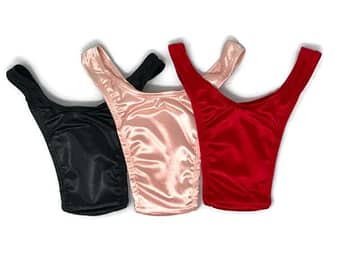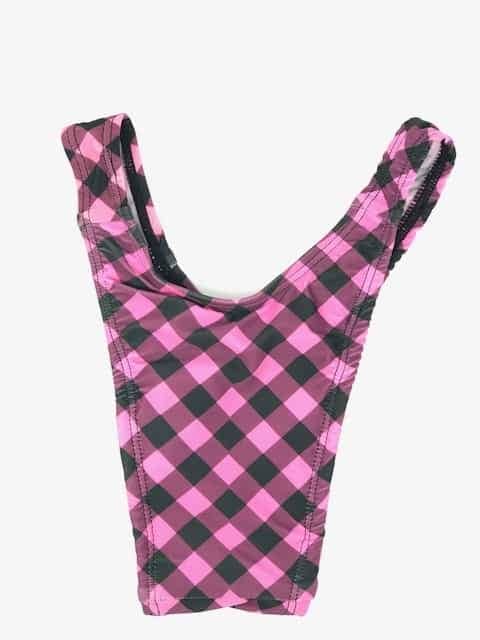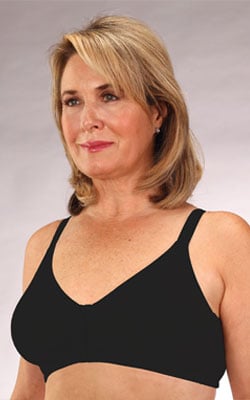- This topic has 30 replies, 12 voices, and was last updated 2 years ago by
 Hippie.
Hippie.
- AuthorPosts
- January 4, 2022 at 12:20 am #603458
Bonus question to poll below: Did Audrey Hepburn encourage women to wear pants before such was considered appropriate because she was a crossdresser?
- January 4, 2022 at 4:25 am #603479
I think most women crossdress. There’s nothing that is out of the ordinary to see a woman wearing mens pants or a flannel shirt. Wearing pants and shirts is practical clothing for doing many tasks. I don’t think a woman would want to change a tire wearing a skirt and heels, not that any woman would ever want to change a tire.
Many women will say shopping for and wearing men’s clothes just fit better. I’ve even heard of women admitting to wearing their husbands T-shirts to bed when they are out of town so they can smell his presence.
As M to F crossdressers we wear women’s clothes for a whole different reason. To us it’s all about feeling feminine. When I’m wearing a dress the last thing I’m thinking about is changing a tire, or doing any other masculine task. I wish I could openly say I sleep in my wifes nightgown so I feel closer to her when shes out of town. Don’t think that would go over very well with my friends.
There’s nothing exciting about men’s clothes, it’s just practical attire that has no sexual attraction to it. Women’s clothing is just the opposite and lingerie is something that is totally taboo for us men to want to wear.
Women get to openly enjoy both sides of the fence. Looking and acting totally feminine or enjoying feeling empowered by masculinity and living in a man’s world when they choose to.
It would be so nice if us men were allowed to spend time in the blissful world of femininity when we feel the need to escape masculinity and the man’s world.
- January 4, 2022 at 9:18 am #603556
I would venture a guess of about 2 percent
- January 4, 2022 at 9:22 am #603558
I wear jrans, t-shirts, trainers etc but I don’t consider that as crossdressing. I’m more comfortable in those clothes than skirts and dresses but it has nothing to do with excitement it’s just what I’m comfortable in
- January 4, 2022 at 9:48 am #603565
Thanks so much, Mandy, for your reply. I would especially seek responses from genetic women but don’t expect many.
You don’t fit the definition of “CD” as I defined it for this poll. I fully recognize that men’s clothes can be more comfortable or functional (pockets for instance); my focus is on trying to ascertain the percentage of women who “crossdress” for reasons akin to crossdressing men. I have met such women and suspect there are many out there, but since there is no stigma attached to women wearing male attire, it may be hard to imagine a female being attracted to wearing male attire for reasons similar to a male oriented toward wearing female attire, and the prevalence of such behavior in women is tough to gauge.
- January 4, 2022 at 2:54 pm #603642
 Anonymous
AnonymousI guess we would have to think about it in different ways. Technically, every time a woman may wear a sweater, a jacket, or a shirt belonging to a man (Husband, dad, boyfriend) they are crossdressing indeed.
But when you mix in intention, things are not as clear. Is any of them trying to conceal their femininity when they do so? Are they dressing 100% in men’s clothes? Very few would do that, other than for Halloween, or a play.
Then the issue that fuels a lot of the (not needed) self justification for a lot of CDs… “if women can wear pants why can’t I wear a skirt?” *sigh* Most women wearing pants are wearing WOMEN’S PANTS. Designed for women, cut and tailored for women. That is NOT crossdressing.
So, in my opinion, very few women crossdress. And other than drag kings, I doubt any will attempt to try to pass as men.
Gabriela
- January 7, 2022 at 1:13 am #604433
There are many notable women in history who HAVE tried to pass as men, many of whom were successful until their secret was revealed after they died. Some women have posed as men in order to get into the service to do something they deemed valuable; others simply have felt “manly” and desired to enjoy the pleasures a man is afforded with ease (such as smoking cigars). For every woman making the history books I’m sure there are far more who live under the radar. Fortunately, for every woman wishing to burn her bra there is, I suspect, at least one man willing to gallantly volunteer to save that garment from destruction.
- January 4, 2022 at 4:13 pm #603665
 Anonymous
AnonymousHi Rhonda,
I’m not sure about this premise that many women wears men’s clothes and therefore some must be cross dressers
In WW2, women who were previously ‘stay at home’ started working in factories to make up for enlisted men. Wearing women’s clothes of the day was often impractical and could be downright dangerous in a work setting, hence the shift towards ‘men’ style clothing. And maybe in those days they did use off the rack mens clothes, but I doubt it was very long. before they tailored their own versions.
Fashion and necessity plays a big part.
I remember the oh so drabness of male attire mid sixties, and the psychedelic explosion which saturated men’s clothing with colour, and ‘home made’ tie dyed tshirts that had started off life as plain white. Again it was a fashion that helped transform the mainstream – to a degree.
I also remember reading a disillusioned opinion piece about the legacy of hippiedom, along the lines of “The only thing it achieved was that bank tellers (remember those?) were empowered to wear colorful neckties”. Yes, really. Mainstream men’s clothing was so conservative that colourful ties were a breakthrough.
I’d be more convinced that a woman was cross dressing not by the clothes they wear but by whether they use a binder to squash their breasts, to enhance their appearance. Much in the way that most mtf will wear a bra with breast forms to enhance their appearance.
Marti xxx
- January 4, 2022 at 7:59 pm #603706
Thanks for your thoughts, Marti!
I don’t disagree, but I am NOT saying that women who wear men’s clothes are crossdressers. I am defining a “CD” to be “ one who wears clothes typically associated with the opposite sex because they ARE clothes of the opposite sex.” This is a definition posted for many years in Wikipedia, coined by professor Gilbert at York University. I like it because it goes further than just saying one is a crossdresser simply because one wears clothes of the opposite sex. Wikipedia authors went further, by excluding from the definition of “crossdresser” or “transgender” those who have practical reasons for doing so, such as attending a masquerade or giving a theatrical performance. I think drag queens and drag kings or any who dress for performance would fall outside the definition of being a “crossdresser.” Ru Paul, for instance, would not be one I would hold up to be a good example of a crossdresser. I have often attended plays, such as “Designing Women” episodes performed by men. In talking to the actors afterwards they talk about what a difficult job it is to play the part of a woman and to dress like a woman. It is a job, an act, not who they are. In Shakespeare’s day men played female parts. One could say, as do authors Wikipedia cites, that people I have named are “crossdressing” but they are not necessarily or even probably ‘crossdressers.”
One could cite many other examples of men playing female roles, such as castratos, who avoided voice changes via castration and were so common as to have their own vocal parts… the result of actions being forced on them, typically, not their own choices or inclinations.
We could debate what definitions are appropriate, but what I am really trying to get at is the prevalence of women who are motivated to crossdress for reasons similar to those leading most men to crossdress. Whereas most men remain closeted since they fear non-acceptance if their motives were known, a woman would presumably not have such a fear, so could go undetected. I have met women who fall into that category so have to wonder how prevalent that population is.
One example: I gave a presentation once to a class of Citadel cadets. A female cadet was particularly interested in talking to me afterwards. She wanted advice on how she could shop in the men’s department without fear of being detected as a woman who felt a need to wear male clothes. I recall thinking to myself “How could this be an issue? Isn’t it common for women to shop for their husbands while they sit at home watching football and drinking beer?” Yet I realized that her perspective was similar to my trepidation about buying a bra in the lingerie area, claiming it is for my wife, something I once did, so can definitely relate to. Will my true motives be detected? Probably they will, even though I know full well that men who are not CDs have bought bras for their wives with no intention of wearing them themselves. I can relate other stories which have convinced me that there are women who are attracted to wearing men’s clothes BECAUSE THEY ARE MEN’S CLOTHES. But if I did not hear these stories firsthand I would not think twice about any woman buying any item in the men’s department. Be it a jock strap, speedo, or anything else, my first thought would NOT be that they were buying the item for themselves.
As to women buying binders, my first thought there would not be that they are crossdressers, but that they believe they are men and are considering transition. That is certainly much closer to the object of my inquiry. Women who have confided with me in such things have believed that they were misgendered at birth and need to have a sex change. Gender identity is not the same thing as gender presentation. That said, I really don’t have enough experiences with women buying binders to know whether the tales I have heard are representative of the large population. It may in fact be the case that many women buy binders without having any sense of being a man or transitioning. I’d love to know more about things like that. Women who crossdress COULD be a population even more prone to secrecy than men who crossdress… then again… perhaps such women are truly rare. I’m just curious to know more and to be more inclusive in my views and understandings.
One thing for sure: There is a huge population of people of many persuasions who have remained very hidden. Universities now typically provide safe outlets to draw such people out so they will feel included among those who are accepting and understanding, while retaining their anonymity so they can walk about campus without fear of detection by those who might not approve. I have spoken to such groups, invited them to dine with me or meet in classroom settings, and participated in gender films and other activities that have opened my eyes to a whole world of people I never knew existed because they are afraid to be revealed. I have had the good fortune to befriend many. I relish any opportunity to expand my horizons. There is nothing new under the sun. I just have not found all the shadows that seek to enjoy the light of day.
- January 4, 2022 at 10:36 pm #603752
 Anonymous
Anonymoushi Rhonda,
I’m not disagreeing with the points and examples you raise. I’m all for diversity, its expression and a much wider acceptance of such. If our exchange has encouraged others to consider the points we have made, all the better! Perhaps I could stop there, but …
For sure there are some women who intentionally wear clothes that men would wear for the precise effect of feeling and looking manly – and feel the equivalent fear of ‘outing’ that many mtfs do when out and about. I’m not disputing that at all. For some that’s (sometimes) challenging enough and all they wanted , for others it’s a point on a path to transition. I’m of the opinion it’s all on the same transexual spectrum, wherever those people lie on it.
For other women it can signify a rejection of traditional expectations – e.g. wearing a skirt or dress. I can definitely relate to this. As a man I have always hated wearing a suit, collar and tie and I had to adjust my life and employment opportunities to accommodate that.
But fashion-wise women have one way or another acquired a much broader range of clothing to express themselves than men do – and also society’s acceptance of such. And hence can hide and pass more easily. But let’s not forget e.g. the ‘skirt and heels’ expectation that still lingers in some spheres – every bit as much as ‘suit and tie’ for men. It’s still a rare politician who doesn’t conform to dressing norms.
As for binders. No hard and fast rule on that. There could be a valid medical reason why a woman used them as a man with breasts might need a bra. If not medical or functional though, my next assumption would be that it might have a cross dressing motive.
Apologies if I’ve started to ramble. It’s good to exchange views with you in a cordial way, Rhonda. Thanks
Marti xxx
- January 7, 2022 at 12:57 am #604425
I really appreciate your sharing your thoughts, Marti!
There is so much we don’t know, and many just don’t see why it matters, but I personally have a keen desire to understand why we are who we are, and to be more aware of those who differ from me, so as to better appreciate and understand others. It has led me a long way down the path of acceptance of not only others, but myself. Coming from a very rigid upbringing where nothing out of the ordinary would be accepted- everything was black and white, right or wrong, with no middle ground- and losing my wife and many friends because they cannot tolerate any who are abnormal… to the point of avoiding talking to anyone or being near them, I realize I have missed a lot in life and probably dismissed many in the process by accepting THAT attitude as appropriate. It takes effort to understand and accept others who differ, and learn from them what they can uniquely offer, but I have found that effort always worthwhile and rewarded. I believe being “normal” is abnormal. I think there is much truth in an ABBA lyric that “everyone’s a freak.” Just like no 2 snowflakes are alike (“they” say, but those folks must live a dull life if they count every snowflake), no two individuals are remotely similar to each other. We’d live in a Willie Wonka world if we were all made out of ticky tacky and all looked just the same… no satisfaction there aside from eating a chocolate bar.
- January 7, 2022 at 11:30 am #604630
I remember those days well. Circa 1971 I interviewed for a job working for Ross Perot, who had carved out a niche for himself in the computer industry and was a Presidential hopeful. I wore brown polyester plaid pants, a wide brown belt, a wide colorful brown and yellow tie, and bright yellow shirt. The interviewer informed me that Ross Perot insisted on white shirts, blue suits, and narrow belts and ties. Needless to say, the interview ended quickly. At a later company my boss, the President, gave me a book “Dress for Success”, which laid out the ground rules of proper attire for executives… white or light-colored blue or yellow cotton shirts, wool suit, and narrow tie with nothing splashy. He told me that when I interviewed for the position wearing a light green polyester suit they hired me IN SPITE of my clothes. If they could only see me now! From that point forward I bought all of my business attire at Jos. Banks, knowing I could not go wrong. During my first visit I overhear d a salesman talking to a lady asking if they carried ties with fish on them; his reply said it all “Lady, we sell ties in good taste, not ties that taste good.”
In my early days of crossdressing I was fine with Goodwill castaways. Fortunately I met an accepting lady who has excellent taste in women’s clothing and gave me a major upgrade. I take all my advice from her. She is extremely observant and detail-oriented. She tries hard to make me look my best.
- January 7, 2022 at 11:46 am #604640
 Anonymous
AnonymousA sweet memory, Rhonda, but you obviously got there in the end. For me it was IBM – I don’t (didn’t) think so!
But drool, how nice it would be to have a ggf to challenge my dress sense.
Marti xxx
- January 7, 2022 at 12:00 pm #604649
I would not have wanted a job in that environment. I recall that “IBM” stood for “I’ve been moved.” I would not have fit that culture then, and would be a worse fit now. I eventually walked away from a job and positions where I would have likely been the next President or could have started a firm… Earnst and Earnst in the Southeast, a reinsurance company in Bermuda, and a top position with Allstate. The thought of conforming persuaded me to break away from the corporate world and pursue my own business ideas. That was the best move I ever made… riskier than I anticipated at the time, but I reached a point where success, to me, meant doing what I wanted to do… damn the torpedoes. When I first allowed myself to be dressed as a female I knew the genie was out of the bottle and the toothpaste squeezed from the tube, never to return. It has had its negative consequences, but at least I am comfortable in my own skin.
I had a manicure the other day when getting glammed up for a special event. I narrowed my dress selection down to 12, including 3 still with tags and realized I need to get out more. Determined to take full advantage before Sunday, when my SO warns me that attending symphony en femme in this small town would not be a good idea, I plan tonight and tomorrow night out on the town before having to shed the polish, restyled wigs, and dresses.
- January 7, 2022 at 4:39 pm #604742
I worked in the electronics industry and IBM had the reputation of havind the strictest dress code; White button down shirt and a dark suit and plain tie, I may have this wrong but that is what we were led to believe. Quite the contrast from Silicon Valley where they were lucky if you even turned up.
I am still over awed how women have pinched all male attire and made it virtually their own and not to be worn by males. My very accommodating SO likes me with stud ear rings, that is small, but though in the house she admires my long sparkly ear tings she is not happy about me wearing them out when with her, though she says I can if I insist. Not worth the hassle. Best to all, Marlene.
- January 8, 2022 at 8:49 am #604951
Wise wife! I wanted to take full advantage of my manicure (sparkly red) and my girlfriend’s Christmas gift to me (a diamond-studded pendant, with my birthstone in the center). We shopped for a longer silver chain than it came with, the other day, and have had two dressy outings so far. I thought we could go for a third tomorrow to symphony, but she wisely reminded me that it is a small town and goes beyond a pragmatic threshhold of risk. We need women to pull our heads out of the pink fog now and then. Our male (non-thinking-it-through; ready, fire, aim) sides can get us into trouble.
- January 8, 2022 at 9:00 am #604957
I wouldn’t put the blame on women for “pinching” our male stuff. Men had a corner on stuff like jabeaus, wigs, hose, and heels in the 18th and 19th century, but decided women looked far better wearing such items than men. I think that had a lot to do with encouraging women to convert, to the point where such items came to be seen as women’s clothing. The status of men sometimes was reflected in the height of their heels, but seeing women walk in them was far more satisfying than gaining status.
- January 4, 2022 at 8:16 pm #603710
If the same proportion of females dress to be especially feminine as do males, then about 3% of females cross-dress.
If you mean how many females wear masculine clothing, about 90% except that they feminize that masculine clothing so you don’t really notice.
If you mean how many females dress to be expressly masculine, that is a hard one and I would guess maybe 1%.
The sexes are not opposites, they are co-operating versions of the same species. I generally use ‘other sex’.
Perhaps you mean Katherine Hepburn. De Givenchy got caught on that one as well.
Araminta.
- January 5, 2022 at 9:20 am #603878
Thanks for your reply and correction on Hepburn, Araminta.
I guess communicating what we want to convey is a key issue with gender terminology. Your third assumption is closest to what I reference.
I certainly agree that the sexes are not opposites. Certainly the traits we commonly attribute to femininity or masculinity, such as sensitivity, aggression, tenderness, etc. can be found in everyone, to different degrees. Perhaps the expression of traits by a male commonly considered female is what fundamentally upsets many, or is not accepted and in need of change or correction because it is felt to be “wrong”.
- January 5, 2022 at 2:52 pm #603994
“Perhaps the expression of traits by a male commonly considered female is what fundamentally upsets many, or is not accepted and in need of change or correction because it is felt to be “wrong”.”
Pretty much why I harp on the need to understand ‘gender’ (meaning a type, tribe or sort) and ‘sex’ (i.e., the reproductive ‘sections’ of a species) as separate. It involves the need to see the distinction between the subjective and objective and to realize both can be very real. This allows us to see that there is no contradiction between a male being feminine more than there is between there is between being hard or fuschia. One can be both and colour is mutable. Hardness is usually, well, hard. However, popular ‘knowledge’ has (rather recently) overwhelmed and overridden that distinction. It was, at least in my lifetime, fairly generally accepted at least from about 1400 and 1990. Using ‘feminine’ to mean ‘female’ was actually defined in reputable dictionaries as a ‘jocularity’; probably a form of insult amongst males I assume. The best dictionaries, however, are historical and not authoritative dictionaries and follow etymology and usage. Recently they have been required (in English at least) to conflate the terms creating the impression of a congruency.
In a sense, this also relates to the question of the prevalence of FtM (Feminine-to-Masculine) ‘cross-dressing’ and raises some intriguing issues. My 1% is based on my observation that FtM’s seem relatively rare on-line and I have made hasty searches to seek some anecdotal information of interest. I have seen enough to recognize a distinctive parlance with specific terminology that did not resemble usual, male colloquialisms but were still distinctly masculine.
Anyway!
I was struck but the dearth of FtM’s on-line in contrast to a relative flood of MtF’s. I remember hundreds of websites, probably most gone now. Then the forums. Some people just cannot resist showing off. In most instances, you couldn’t blame them. So I sort of intuit that there were a 1% prevalence of FtM’s amongst females in the North American/West European sphere. Maybe less.
However:
Suppose that, as suggested here, woman wearing supposedly ‘male’ clothing was something that was ‘normalized’ especially in the past 80-years. There would have been some social pressure from the variation of Feminists who existed at the time. I suspect that de Beauvoir’s tome would have never had such a wide reception had not the timing been accurate. That work probably gave rise to the similar works of the late 60s and early 70s. This gave academic and some social attention to gender issues rather than simply sex issues.
So! Suppose we have become inured to the sight of ‘male’ clothing on females. Seems to me that Yves St. Laurent actually made something of that. The ‘feminization’ of ‘male’ clothing has become so ubiquitous that many MtF’s finding the resulting garments quite attractive. Possibly FtM prevalence than objectively exists more frequently than we subjectively perceive. Perhaps it is even a plurality! It might explain, in part, the existence of certain retail clothing stores and the disappearance of others.
These are actually important questions! I find it startling that there are no objective studies available. Or maybe they are. I stopped looking a couple of years ago.
Araminta.
- January 7, 2022 at 1:54 am #604446
Great stuff, Araminta! As far as no objective studies being available, there is a dearth of objective studies with respect to MtoF crossdressers. The vast majority go to tremendous lengths to avoid detection. There was a study done by a famous newspaper journalist in England who was known to examine many phenomena. He did a survey that attracted a great many to reply who probably would not have done so had he not had a good reputation. But even so, the fear of reply was so great that tremendous lengths were taken to retain anonymity. One person, for instance, hand-wrote the survey and traveled a vast distance to carry their reply to a post office nowhere near their home. Consider that men are generally thought to be or may be by nature be greater risk-takers than women. If a typical male crossdresser cannot muster courage to step out of the closet, to even confess to his wife, how likely is it, really, that a woman would take the risk to come forward? Being seen as a non-conformist is perceived to be very risky business, probably more so for women than for men, I would suspect. I could tell many tales of crossdressers who have desperately wanted to meet me to help them come out of the closet. I go to great lengths to find safe places, but in the end, most fail to show. In many cases that process continues for years. I know some who I have contacted regularly for more than 10 years who insist that they will make a break within the next few days, but never do. I recall one who traveled about 100 miles to meet our support group. I was not surprised at the no-show, but when I called him I learned that he was in the parking garage, unable to turn off his car engine. I came down to greet and escort him and had to pry his white-knuckled fingers loose from the steering wheel. I’m talking about a man who probably played fullback for a professional football team, and, yes, I know football stars, those in the military with purple hearts, statesmen who are very well known, and other notables who have the same level of fear.
I could not verify this as true, but I have heard that a psychologist who aids many congressmen says that many of her clients wear panties when speaking from the lectern. It would not surprise me if she had female clients.
- January 7, 2022 at 7:14 am #604552
Hi Rhonda!
Oh too funny, in a way, I recall that parking garage incident years ago. My wife and I had just entered the hotel parking garage, looking for a parking spot, before going up to the monthly support meeting. Suddenly, we spotted you, en femme, phone in hand, wandering around the garage, as if lost. You informed us you were searching for a terrified CD, sitting in her vehicle, unable to exit the vehicle.
I seriously doubt if that level of dedication and support exists any longer today in that group. In fact, speaking recently with one girl, she told me she had no idea the group now or ever had a support function!
Slightly different subject. This could explain why when I see so many new girls signing on for the first time on to CDH, and their profile shows them living within a few miles of me, I contact them and hear nothing back. Granted, their profile virtually always indicates they are a closet CD, which tells me they are going to want to protect their privacy most likely. Thus, I will offer to meet with them in male clothing. As is the case though, almost always, I hear nothing back.
One time I did meet with a CDH member, and it turned out he was just a lonely guy looking to make friends and not really a CD. He has since left CDH. I suggested he try Meet Up groups.
Atlanta does have a significant CD/Trans population, and in my travels, I will often spot girls out in public. On my last outing, I had the unusual experience of observing a person in male clothing in Lane Bryant, purchasing several bras for himself. How did I know they were for him? Because I overheard the staff speaking with him about having his measurements on record and how a particular style bra may or may not fit him properly.
Hugs,
Peggy Sue
- January 5, 2022 at 10:20 am #603900
I have no idea what number might be valid because, first, the definition of crossdresser is not what I would consider absolute in our current state of human development. To me it’s still in flux..,and may be for some time to come…regardless of what supposed ‘authorities’ would like to have you believe. And second, I still have concerns over the validity of people openly responding to supposedly legitimate surveys like this. If I were randomly asked to fill out a questionnaire that is absolutely guaranteed to never be traced to back to me, I’m still not sure I would be that open…even with me being here. (I have more trust in all of you than I would in a stranger asking me about that, privacy notwithstanding)
Perhaps the more confusing situation is that to me anyway, the word crossdresser and crossdressing seem to be really two different concepts. Lots of people who might ‘crossdress’ (like has been mentioned, people in the acting world, drag persons, etc) might never consider themselves or identify as even remotely ‘crossdressers’. So here we are using the same basic root – crossdress – to mean two fairly different things. Ask yourself do you ‘crossdress’? Does a drag person ‘crossdress’? Do you both identify as crossdressers? That’s a tricky position, I crossdress but I’m not a crossdresser. I work…but I’m not a worker?
I’m more curious about how and why the concept of males wearing pants and females wearing skirts (or dresses) actually came from. Probably some misogynistic dictate in some far past. It’s interesting that males can wear ‘kilts’ and get away with it (probably some minor teasing) but to me it’s just a type of skirt. Even during (the most widely accepted) Roman times, both males and females wore togas, although there were probably some slight differences. That surely didn’t last.
- January 6, 2022 at 12:05 pm #604269
Thanks, Chloe, for all you insights!
There is a lot to unpack here.
First, you are correct in noting there is no universally accepted definition of “crossdresser.” That’s why I posed the question after setting forth the definition to be considered solely for answering this poll question, hoping to eliminate interpretations which might include those who dress for performance, masquerades, comfort, and other reasons. I have personally known several GGs who have worn male attire BECAUSE it is male attire, and not for other reasons, which we all know exist, But it is difficult to determine how large this population is, since absent response from an individual as to their perspective, how can we deduce motive? It is to me akin to legislation that entitles those born one sex to use the restroom of the other sex if they IDENTIFY as being that gender. Huh? How can anyone know how I personally identify? I could understand the purpose of a mandate based on presentation, but if I internally identify as male and am PRESENTING as female, it would seem I am required to use the men’s room. Is that the INTENT of such legislation? I doubt it.
As to the point about being reluctant to answer such a poll, that is certainly valid. We can never know whether those answering a poll are representative of the larger population, including those who don’t. Still, I think polls can be informative and PROBABLY representative of those who decline to answer, assuming honest answers among those who DO answer.
One must always keep in mind the audience to which polls are directed, as answers may be valid for that audience, bur perhaps not for others.. I am personally bothered by the mis-use of data such as that gained from the Williams studies, whose respondents are comprised almost entirely of transsexuals, yet used to draw conclusions regarding all in the “transgender” population, including crossdressers who would rarely be queried in their database. So we hear numbers like 2% being “transgender” and think that includes crossdressers when it clearly does not.
I think I addressed your very valid point that one “crossdressing” does not mean such a person is a “crossdresser.” That’s why I personally like Gilbert’s definition, which explicitly excludes from the term “crossdresser” those who have reasons for crossdressing other than the fact that they crossdress in clothes of the opposite sex BECAUSE they are clothes of the opposite sex. This would exclude performers, men wearing kilts or garb widely accepted in their society as male attire, those who crossdress solely for convenience or comfort, and other outlying reasons which don’t get to the heart of the poll question.
As to the point about origins, Genghis Khan is often referenced as being the first to introduce pants to men, as typical attire at that time (which might be viewed feminine in OUR time) was unsuitable for riding horses. Tunics and garb deemed feminine in current Western cultures were typical in earlier times, and still are in some societies. Clearly that need not imply that men wearing such garments were or are crossdressers.
There are tons of different reasons given for the oft-referenced Deut. 22:5 passage proscribing men from wearing female garments, but the one I personally think most accurate is that in those times there was no difference between male and female garments… all wore tunics. Leviticus and Exodus focus on actions which had practical application in those days; far less so in ours. As just one example, lepers were considered unclean and diseased, so banned from the city to avoid spreading disease… no longer a problem in our day as we know leprosy can be cured. Also unclean were women during their menstrual cycle. Absent underwear (and modern conveniences for cleaning clothes), bodily fluids of both men and women could have led to health issues for both sexes if sharing clothes; the reference to not wearing the garments of another may simply have been a warning against wearing unclean clothes, not a mandate against crossdressing for other reasons.
As to women wearing pants, Hepburn is often cited as the lady who first led Americans to accept this practice. Acceptability of clothing norms varies widely from culture to culture.
What I think most important is to learn why men and women defy the norms of their culture. Specifically, to what extent do men or women who break the norms do so because of a strong internal drive to do so, which is independent of job requirements, masquerades, and a host of other reasons which are not truly associated with that internal drive to present in a way which is outside the norm?
Phrasing questions intended to get useful data responding to this question is difficult. In spite of my best efforts, the poll question remains confusing to some. Perhaps others can phrase a question in a better manner than I have.
The participants of this group may not be representative of a broader segment of society, so any answers developed from this group may not be credible in numbers or applicable to broader populations. Still, I think poll questions, if correctly presented and understood, can lead to a certain level of understanding and perhaps point to areas where common assumptions need to be further tested and challenged.
- January 7, 2022 at 4:14 pm #604735
Brilliant! Best, Marlene. PS It would take a doctoral thesis to even scrape the issues you raise. Too old for that!
- January 8, 2022 at 1:23 pm #605056
As to the difference between being a crossdresser and crossdressing, consider the photo below. At this theme party, asking guests to dress as a dignitary, such as a Starfleet Commander, I dressed as an 18th century English Country gentleman: buckled shoes with heels, tights, jabeau, blousy top with lacy sleeves: Was I crossdressing? Would I be perceived as a crossdresser?
https://www.dropbox.com/s/0w9o65ap63n8moj/Screenshot%202022-01-08%2016.22.12.png?dl=0- This reply was modified 2 years ago by
 Rhonda Lee.
Rhonda Lee.
- This reply was modified 2 years ago by
- January 7, 2022 at 12:51 pm #604658
I’m not as old as many of you are here, but I do have a thought or two.
Men’s clothing have always had an “occupational” practicality.
At first, men were predominantly warriors, from goat-skins and spears to Medieval chainmail and the deadly mace to khaki army greens and AK47s. The clothing had a “toughness” to last a long time and to save his life!
Women, not traditionally bound by stupid male wars, looked at the world very differently, even though they had to “obey” their man.
So, man comes home from war, is tired, sickened, perhaps shell shocked, and needs the loving care of his woman who had time to knit soft and silky things that man found pleasing to the eye.
So, if a man wants to wear his woman’s clothing, then the presumption is that he wants sexual pleasure. But we all know that this isn’t true! For many of us, it’s NOT always about sex, but something deeper that no one else can get their heads wrapped-around.
As for what women want? I haven’t figured that one out yet. And if anyone ever does, then I hope you become super rich!
Hugs,
Barb 🙂
- January 7, 2022 at 12:54 pm #604659
Excellent points, Barb!
A hopeless pauper
- January 8, 2022 at 9:06 am #604960
 Anonymous
AnonymousOh I’m sure that through History there have been may women who did that for sure….
But the poll and my approach to it was set in the present time. Since now women don’t need to be masculine to be powerful, that is not the case anymore. There are very few areas in society forbidden to women, if any (other than in some religions maybe).
- January 8, 2022 at 9:28 am #604969
Here’s a link to a photo I love to show classes, with the question “How many crossdressers can you spot?” It was taken at a reception after a holy union between two lesbians. One is dressed in male attire, one in female attire, and I am wearing a dress given me by the latter. I played piano for the ceremony. The only thing frightening about the experience, from my perspective, was that I was situated on a piano bench close to the bride dressed en femme. She wore very high heels, which were very narrow and were not meant to support her weight. I feared a mid-ceremony wardrobe malfunction and stood ready to catch her if she fell.
This photo also demonstrates other diversities such as race and legality of same sex marriages. They were legally married in NY the week before their “Holy Union” ceremony in NC, as they could not legally do this in NC at that time. If we go back further in time, racial differences were also illegal. Social norms have changed dramatically in relatively short time.
I present this here to stimulate your thinking as to whether the bride dressed en drab is a crossdresser.
https://www.dropbox.com/s/rrw8hxzgvi8zx5p/Screenshot%202022-01-08%2012.06.29.png?dl=0
- January 16, 2022 at 4:30 pm #612619
I would say 100% today
- AuthorPosts
- The forum ‘Crossdresser Heaven Polls’ is closed to new topics and replies.














Recent Comments